Final report for FNC17-1085
Project Information
Heart and Soil Farm is a family owned, small scale vegetable farm that uses organic growing methods to produce vegetables and some fruits for CSA (Community Supported Agriculture), farmers market and wholesale sales. The farm has been in operation for 6 years. Heart and Soil Farm currently operates on 13 acres outside of Gardner, ND. Heart and Soil Farm also grows commodity crops on 65 acres of land near Grandin, ND that transitioned to certified organic in 2018.
Produce at Heart and Soil Farm is grown using organic methods such as promoting soil health using cover crops, green manure and adding compost via composted manure as well as compost made on the farm. Crop rotation is employed to ensure soil health when growing the roughly 60 vegetable varieties on small acreage. Other organic/sustainable methods used are companion planting flowers to attract beneficial insects and mulching using alfalfa hay. Weeding on the farm is done either via tractor cultivation, by hand or using mulch. Sustainable practices are part of our farm mission and we pride ourselves on working toward greater harmony with the environment while growing an abundance of healthy, local food for our community.
This project goal is to help small-scale, organic growers increase their yield of pest-free brassicas that can be sold to retail outlets. The intent of the research is to determine whether the input of time and material cost paid for itself by increasing the number of Brassica crops that were pest-free and therefore able to be sold to retail outlets such as grocery stores and cooperatives. Some of the significant pests in the Red River Valley for brassica crops are cabbage looper and imported cabbage worm which are difficult to control using chemical-free organic methods. Two years of data will be collected from growing brassicas in four plots – some under fabric low-tunnel cover with and without companion flowers to attract beneficial insects.
(The results after the first year were mixed. Many unforeseen barriers such as wildlife damage to low cover and drought conditions created challenges to plant growth and increased labor time which was spent on repairing fabric. After experiencing these difficulties in the first year, we decided to conduct the research a second year to compare the results. For the second year, we modified the planting set up and moved the project to our new farm in hopes of lessening the challenges of animal damage to the low tunnels.)
In designing the year 2 research, the plot was condensed into 2 beds – one with fabric cover and one without. Phacelia*, also used in year 1, was already planted throughout the field. The types of brassicas were also condensed from broccoli, cauliflower, green cabbage and red cabbage to broccoli, cauliflower and green cabbage. We decided it was unnecessary to plant two cabbage varieties. Pro-19 floating row cover fabric was used because the first year we observed heat damage to our plants from the heavier fabric. Another benefit, we learned, of using a lighter fabric was that we were able to see through the fabric into the low tunnel and better monitor plant growth.
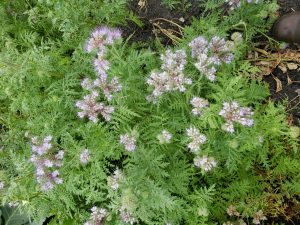
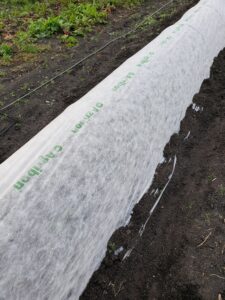
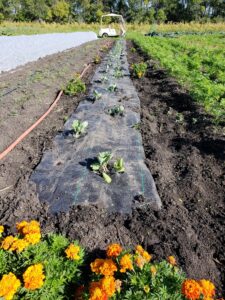
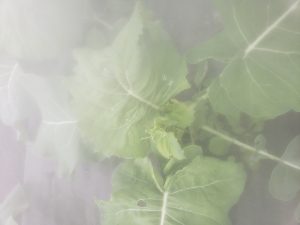
The marigolds and brassicas were grown from our seed by a local greenhouse due to lack of space in the farm’s grow room. Seedlings from the greenhouse were hardened off on the farm. The beds were prepared with drip line and plastic mulch to limit weed pressure as is done with all of our brassicas. The plants were planted on September 4, 2018 on a 75 degree day. The marigolds were planted on September 5, 2018.
Bed 1 (control bed) was 50 feet long, ran north/south and had no low tunnel fabric. The row was planted with cauliflower, broccoli and green cabbage. Established marigolds were planted around the southern half of the row
Bed 2 was also 50 feet long and ran north/south. The row was planted with broccoli, cauliflower and green cabbage and covered with lightweight Pro-19 fabric immediately after planting took place.
A written record of observations was taken weekly. During the first part of September, both rows of plants did well. As the month progressed, however, we noticed leaf damage inside and outside of the floating row cover. At planting, minimal cabbage looper damage on the plants that were hardening off outdoors was visible. Every effort was made to remove and destroy, by hand, any trace of the pests during planting but it is possible some remained and lived inside the low tunnel fabric.
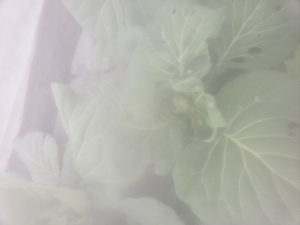
On October 1, there were no signs of pests but some plant damage was visible. Frost from September 28 and October 3rd and 4th had also damaged plants. The marigolds did not survive the frost from Sept. 28. By October 11, many of the plants were dead from October 9th and 10th blizzard conditions. Part of the low tunnel had collapsed under the weight of the snow collecting on the fabric. We continued to let the few remaining plants grow, hoping for warmer weather as the two previous years had seen long, fairly warm falls. Unfortunately, nothing survived and the plants were pulled out on October 16th and 19th. Small tears were visible around the base of the low tunnel during the tear-down process that had not been observed prior.
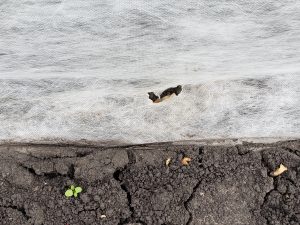
Brief discussions of this year’s research were talked over with NDSU researchers who were on the farm planting their own research plot. Had there been any data collected or a favorable outcome that might help other growers been realized, we would have compiled the information for dissemination. Unfortunately, this season’s trial did not have any successful outcomes. No measurable results were achieved in year 2 of the research. The plants did not survive early frost and snowfall so no yield information or data are available. Anecdotally, the plants under the low tunnel did grow faster when the weather began to cool at night but continued to suffer cabbage looper damage.
In previous seasons, no interventions were used when cabbage looper damage appeared. The brassicas harvested were either acceptable to sell in at least one of our markets or were not edible and added to the compost pile. This season, we did intervene by using OMRI-listed Bacillus thuringiensis (commonly referred to as Bt) in the main field only as pest pressure was high throughout the season. The grant plot was not sprayed. The intervention added time and expense but we were able to harvest the majority of our brassica plantings with minimal pest damage. They would have been marketable to retail outlets but we chose to market them through our CSA and farmer's market stand.
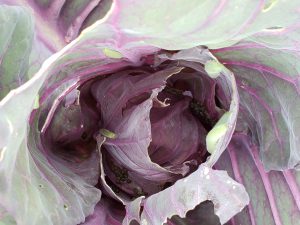
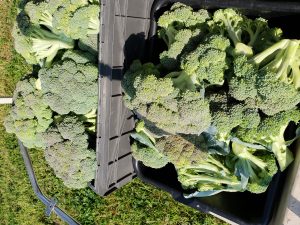
We were unable to overcome our barrier; in two years of trials, we have not harvested any plants that were of retail quality from the research plots. Each year, weather and other factors coupled with our limited planting time made the project challenging. The result was unfavorable outcomes in year one and no measurable outcomes in year two. Due to the very late spring in 2018, we opted to set up our research plot in the fall to avoid the heat damage experienced in year one’s late spring planting. Although the cabbage looper/imported cabbage worm activity typically slows toward the end of the growing season, they are still active in the field. What we had not predicted, however, was the early start to winter. The first frost experienced on the farm was September 28, just 24 days after planting day. Subsequent frosts came on October 3rd and 4th and two inches of snow arrived October 10, 2018. On a working small-scale farm, this intervention is too costly in both time and materials.
The most surprising find this year was when the plants under the low tunnel were taken out, 10 plants had been chewed at the base and a few snapped completely off at the stems. Voles were found living under the plastic mulch. By comparison, the rest of our main field where plastic mulch was used with brassicas was inspected but we could not find any chew marks or damage although there was evidence voles had been under the mulch. Under the low tunnel, however, several of the plants had been chewed. It is unclear whether this occurred before or after the frost. Our belief is that the warm and undisturbed area under the low tunnel created a very hospitable environment for the voles to thrive.
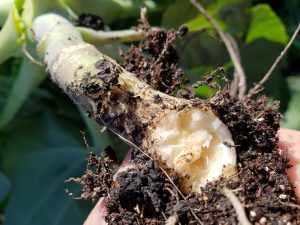
The cost breakdown, as you can see below, shows a significant cost increase for the interventions. The costs shown are for materials only, labor costs are not included. The time required to set up one row with fabric is approximately 30 minutes per row which includes setting up the hoops, covering with fabric and burying the fabric sides. Companion planting will add another roughly 30 minutes for a one time set up. The labor time does not include setting up drip tape and plastic mulch as this is done for every brassica regardless of the intervention used. If you expand this out to the entire field of roughly 22 rows, that is an extra 11.5 hours of labor. This also has to be done on a relatively wind-free day and as most of the brassicas are planted in the spring, this labor would be added to the busiest time of year. The labor for Bt application is approximately 1.5 hours per application, multiplied by 4 applications per year - roughly 6 hours of labor over the course of the season.
The cost breakdown is as follows:
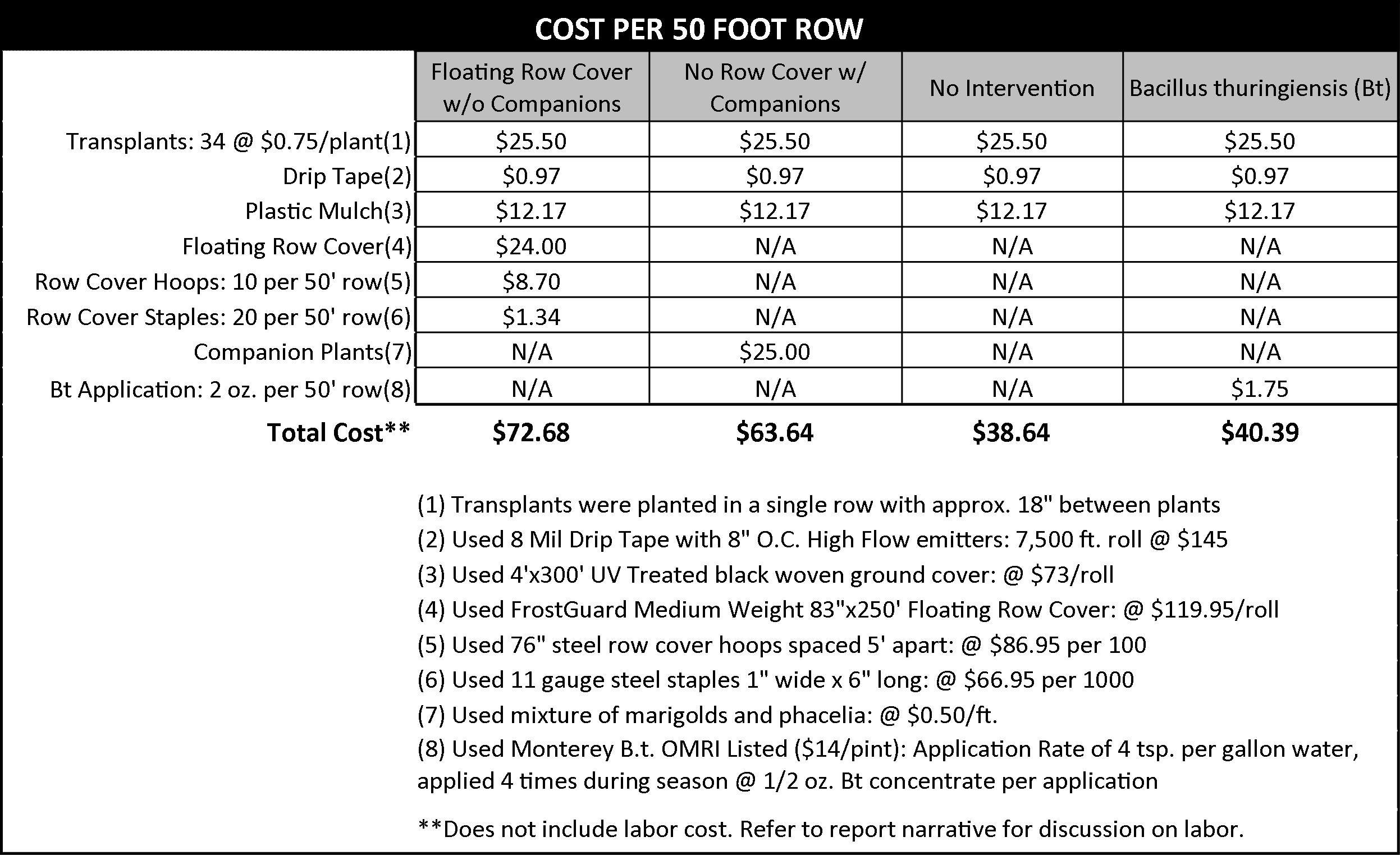
This system is more expensive than other pest control strategies. The project was done on a very small scale, we grow over a thousand brassica plants each season and the time needed to set up, monitor, and maintain this system over multiple crop successions is more than we are able to do on our farm of 2 people. The low tunnel can be very effective for trapping heat and even deterring some pest pressure but it has not demonstrated that it can be as effective as using organic sprays to stop or hinder cabbage looper/imported cabbage worm damage.
*Phacelia tanacetifolia, common names lacy phacelia and blue or purple tansy, is an herbaceous, non-legume annual in the Hydrophyllaceae family. The plant is used to attract beneficial insects such as bees and hoverflies as well being used as a cover crop and ornamental plant.
The project objectives are:
1. Control damage caused by and presence of cabbage looper/worm on brassicas without the use of chemicals.
2. Use low-cost, low-labor intensive, easily - replicated methods to control the cabbage looper/worm.
3. Increase sales of small-scale growers by growing more brassicas that can be sold to retail outlets.
The project aim is to use fabric low-tunnel cover and companion planting of flowers to attract beneficial insects in order to control and/or prevent cabbage looper and imported cabbage worm from damaging the brassicas. Damage is caused by pests chewing on the plant and reproducing/living inside of the plants. If this method can control the pest population and is relatively low-cost and does not significantly increase the labor of the farmer(s), it could increase the ability of the grower to sell more vegetables which would translate into more income. This could also mean more local, organically-grown vegetables available to the community.
The project will replicate particular growing methods as well as control plots for two years on a working small-scale farm to determine whether it is effective in controlling pests, is inexpensive and does not require a large increase in labor. At the end of the project period, if it is successful, these methods will be shared with other growers.
Research
Year 1 - The intent of the research was to determine whether the input of time and material cost paid for itself by increasing the number of Brassica crops that were pest-free and therefore able to be sold to retail outlets such as grocery stores and cooperatives. The materials used were: mature plant starts, drip-tape, staples, mulch, fabric low tunnel material, metal hoops, flower seed and flower starts. We also used flags and sticky traps which were not on the original materials list. Our operation uses drip tape and mulch for long-term crops such as Brassicas and we felt it necessary to include drip tape when placing under the low tunnel to ensure proper watering and mulch to help control weeds. The drip tape and mulch were not included in the cost of the trials as this is a regular part of our Brassica planting.
We chose a medium weight fabric to cover the low tunnels. Our reasoning was that this might save on costs for buying a light weight fabric for mid-season and medium/heavy weight fabrics for early and late season growing.
On June 16, 2017 the growing plot was laid out in 4 rows of approximately 60 feet each with roughly 38 plants per row spaced at 18 inches apart. Around the perimeter of the plot on all four sides we planted flower seed using an Earthway planter to attract beneficial insects. We used a Beneficial Insect Mix purchased from Johnny’s Selected Seeds as well as Phacelia seed purchased from Wild Garden Seeds. The flower seeds were planted prior to the rest of the plot being planted to ensure there were established flowers in place at the time of the Brassica planting, roughly 1 month prior. All of the Brassica plants were started in a grow room and hardened off outside prior to planting as is normally done on our farm.
Each of the four rows was tilled several times as the plot used had moderate weed pressure. Every row had drip tape and alfalfa hay mulch to mimic our normal planting practices for Brassicas. Row 1, the control row, we planted broccoli starts, variety Green Magic. Row 2 we planted cauliflower, variety Snow Crown. Row 2 was covered with medium weight fabric held up by wire hoops which was held in place using staples and then buried at the sides and the front and back ends. Row 3 was planted with broccoli again, Green Magic and had marigolds planted roughly every two feet in a zig-zag pattern between the two sides. The marigolds had been purchased in various states of maturity from a local nursery to ensure they would bloom throughout the growing time of the Brassicas. Twenty-six total marigolds were planted in Row 3. Row 4 was planted with cabbage, varieties Red Express and Blue Vantage and covered with material as had been done in Row 2. More marigolds were planted on the outside of the row cover roughly 54 inches apart, 26 total were planted. All of the plants not covered by row cover were hand watered immediately after planting; drip tape system was also turned on for approximately 2 hours on the date of transplant.
The marigolds were purchased from a local nursery as we did not have the space to start them ourselves and made the assumption based on our knowledge of the indoor seed starting space of other local growers that many small-scale growers would also not have the capacity to start both their vegetables and companion flowers indoors.
The original layout included one-third of each bed being planted with each of the three Brassicas chosen; 1/3 broccoli, 1/3 cabbage (both red and green varieties), 1/3 cauliflower. The broccoli starts had better germination and so we had more of them and one of the individuals with a research background who helped us set out the plot suggested doing the broccoli as control on the rows without material which we followed.
In the middle of each row a flag roughly the height of a mature plant was placed and a sticky trap affixed to the flag. Each week, after observations of insects on and around the plants, the sticky traps were collected and new traps put out. This was not part of the original grant plan but was suggested by the researcher from NDSU we worked with to determine which insects were found during the season.
Setting up the 4 rows took 3 hours with 6 people helping. This was more time than anticipated, however, the majority of those helping were volunteers with no planting background who needed guidance and quite a bit of time was taken to explain the layout and discuss the planting techniques.
A simple rubric was created to score each plant that was harvested. Rubric and notes attached. Each item was graded on a rubric from 1-4. Scoring a 1 meant that the item was unsaleable and would be put into the compost pile. Scoring a 2 meant that there was some damage and pests present, this item might be acceptable for CSA use or on-farm consumption. Scoring a 3 meant there was little to no damage or pests, this would make the item acceptable for CSA, farmers market sale and possibly retail. Scoring a 4 meant the item had no damage or pests and was retail quality. HARVEST-SCORING-RUBRIC-HSF-2017
The reasoning behind how we set up the rubric is that each market outlet has its own tolerance for pests. CSA members tend to have a higher tolerance for pest damage and pests present on the vegetable as they are interested in a certain vegetable experience. Farmers markets have a slightly lower tolerance to pests and pest damage as they are looking for more of a grocery shopping experience but are willing to purchase some “ugly foods.” Retail outlets such as grocery stores have no tolerance for pest presence or damage. The purpose of this research is to find out how to grow more brassicas of retail quality, thereby enabling organic growers to expand the number of channels to market their products and increase sales.
Records were kept of which row each plant was harvested from and the rubric score for each item harvested. Harvest notes attached. After harvest, each plant was placed in cold storage as is done with all of the harvested vegetables; then each plant was visually inspected. Broccoli and cauliflower heads were submerged in cold water to flush out any pests inside of the plants. The cabbage plants were visually inspected and a few layers of each head were removed to see if any pests had burrowed into the plant. A record was also kept of where the item was sold if it scored a 2 or above. HARVEST-NOTES-HSF-2017
The project outcome was not what we expected and we learned a lot from our mistakes as well as the unexpected barriers faced. In hindsight, we should have kept to the original planting plan which would have given more accurate results of each crop grown under the low tunnel fabric versus outside.
The unexpected barriers faced were feral cats living near the abandoned buildings on the property continually tearing the low tunnel fabric requiring frequent repairs and the drought conditions faced during the season. Quite a bit of time was spent checking and repairing the low tunnel fabric which also required the purchase of tape and the necessity of using extra fabric to repair large holes.
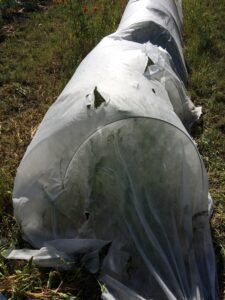
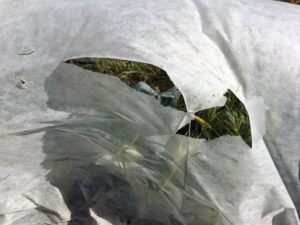
The fabric was also too heavy for the conditions. The planting date in May meant that the plants were maturing during the warmest part of the season and the lack of rain meant a large reliance on drip irrigation which is useful but does not fully replace a good, steady rain. No significant rain fell during the growing time and the temperatures remained in the mid-upper 80s during June, July and August. The heat under the medium weight fabric coupled with the inability of the drip line irrigation to keep up with the dry conditions created an incredibly hot growing environment that stunted the growth of most of the plants and caused burn damage to others. Very few of the Brassicas planted in Rows 2 and 4 were edible. It was also difficult to check on this as we elected not to pull up the row cover during plant development so as not to expose the plants to unnecessary pest pressure. Photo attached.
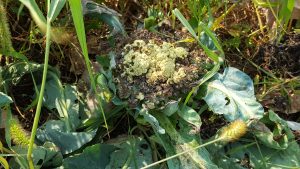
The surprising find was that the broccoli which was not grown under the low tunnel was quite free of pest damage. In the later part of the growing season (late July, August) the plants themselves had significant pest damage on the outer leaves from cabbage moths and loopers but little evidence of pest damage on the edible plants themselves. This was in contrast to the incredible pest pressure in our regular field planting of broccoli in which two entire rows of broccoli were inedible due to the number of cabbage loopers present. The plants in this plot not under low cover were clearly not as stressed as the plants on the other parts of the farm.
The plants underneath the low cover were stunted and many of the cauliflower showed signs of heat damage. Interestingly, the portion of the row cover on Row 4 that was damaged and not immediately repaired had managed to grow more rapidly and the cabbage was harvested and scored rather high on the rubric. The cabbage heads were still slightly smaller than normal (slightly larger than a softball) but not nearly as stunted as the cabbage on the opposite side of the row still under low tunnel (golf ball size) and were relatively free from pest damage. These were put into CSA shares.
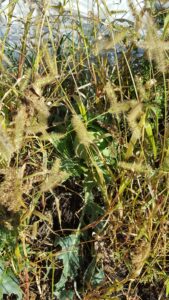
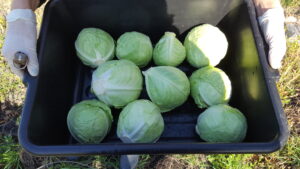
The wildflower seed planted did not germinate due to lack of rain and was quite expensive. The Phacelia did germinate well and attracted a significant number of beneficial insects. So much so, in fact, that we planted some in our regular field as well. We did learn that the Phacelia did not bloom the entire growing season, so next year we will plant it in the spring and again mid-season to ensure bloom throughout the season. We will bring the sticky traps to NDSU to obtain assistance in determining what insects were in the research plot during the growing season.
The findings thus far lead us to believe that fabric-covered low tunnels are not useful in this setting. We do believe, however, that more research is needed due to unforeseen circumstances such as weather and animal damage and mistakes made by us when setting up the plot. In 2018, we will set out another test plot using a lightweight fabric. We will also be placing each variety of Brassica (broccoli, cauliflower, cabbage) in every row as originally planned. After the second growing season, we will have a more clear idea if the labor and expense of this project nets a large enough financial return to suggest implementing on small-scale farms.
Educational & Outreach Activities
Participation Summary:
Year 1 - We reached out to other growers through the Northern Small Farms Alliance (NSFA) Facebook page as well as through the FARRMS organization to invite them to a field day on August 22, 2017.
Year 2 - No report was created due to lack of findings in year two leaving us with no information to disseminate or recommendations to give other growers.
Activities/Tours
Year 1 - The August 22 field day included current small-scale growers, new and emerging growers as well as an NDSU faculty member and student. During the field day, people toured our farm and we gave an in-depth tour with Q&A at the research plot. We were very pleased by the number of questions asked by the attendees and thoughtful discussion around non-chemical pest control methods. Photos from the event were posted on the FARRMS Facebook page. Photos attached. A less formal tour of the 2nd year trials will be offered to interested local growers through the NSFA.
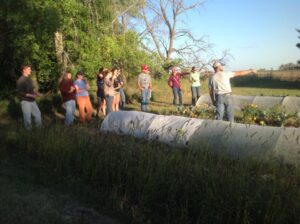
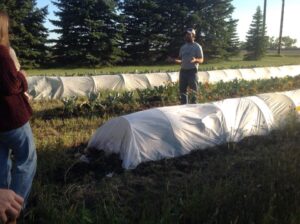
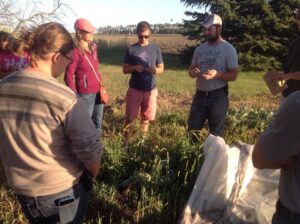
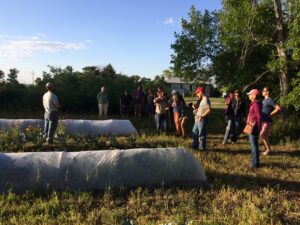
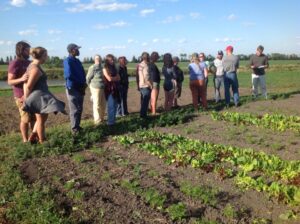
Learning Outcomes
In the first year of the grant, we learned what mistakes we had made in planning and were given some insights on what to try in the 2018 growing season. Our mistakes were not planting a portion of each Brassica variety in every row as initially planned and using a fabric that was too heavy to be used while growing at the height of summer. Unanticipated problems were feral cats continually creating holes in the fabric and drought conditions coupled with heat creating difficult growing conditions inside the low tunnels.
The barriers were how much time went into setting up the rows with fabric and the difficulty in checking on the plants during the growing period. When we were able to see the progress of the plants toward harvest time, it was too late for many of the plants that had suffered from excess heat. In the future, we will uncover the rows more frequently even though this will increase the amount of time spent monitoring these beds. The biggest success of this first attempt was how many beneficial insects were brought in by a relatively small planting of flowers. We immediately implemented planting in the larger field after observing the number of beneficial insects and will continue to expand that in future years.
Year 2 Lessons Learned
In a working farm environment, what we have learned is that setting up the low tunnel system is difficult and time consuming. The environment under the low tunnel can trap heat on warm days causing heat damage, enable rodents to thrive and allows extra weight from snowfall to catch on the fabric and collapse on the plant. In a more controlled environment, this system may work but it did not for us.
Disadvantages
• Low tunnel fabric may deter some cabbage looper but is costly to set up, maintain and monitor to ensure the low tunnel environment itself is not causing problems (e.g. causing heat damage, enabling rodents population to increase) on a full-farm scale.
• The low tunnels are only effective when the growing conditions remain relatively normal in terms of weather. Damage from wind, excess heat or cold seems exacerbated by the low tunnel.
• Animals and wind cause damage to the low tunnel fabric on a regular basis and create extra monitoring and maintenance.
• Flower plantings alone do not seem to invite enough beneficial insects to decrease the cabbage looper population.
Advantages
The following parts of the project have been integrated into our regular farming practices.
• Planting phacelia* is now a regular part of our farm layout. The flowers attract a high number and diversity of beneficial insects, seed is relatively inexpensive, easy to plant and are hardy once established. The flowers also add visual appeal to the farm.
• Use of low tunnels to create a warmer environment for plants to extend the growing season.
• We feel that weather extremes such as have been experienced the past few years are the ‘new normal’ and now spend more time monitoring plants for pest pressure that increases when the plants are under stress enabling us to intervene before problems get out of control.
Having gained a better understanding of the difficulty in research done on a working farm, we have opened our farm to small research projects conducted by a local University. This enables us to help researchers use a real-world farm environment while allowing us to focus on farming.